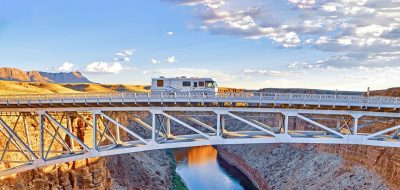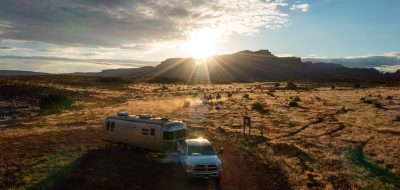Montezuma Well is a detached unit of Montezuma Castle National Monument located approximately 11 miles north of the park. It’s not actually a well and has nothing to do with Montezuma but being wrongly named doesn’t detract at all from its serene beauty.
This unique geological feature is a limestone sink formed long ago by the collapse of an immense underground cavern. This continuous flow of warm, fresh water has created a lush, verdant oasis in the middle of desert grassland. Such a reliable source of life-giving water has lured humans for thousands of years, although Montezuma was never one of them.
Early settlers to the area believed that the exquisitely-preserved five-story cliff dwelling belonged to Aztec emperor Montezuma. In truth, the “castle” was built by the Sinagua and was deserted a century before Montezuma was born.
Yet the name stuck to both the ruins and the beautiful pond which measures 55 feet deep and 368 feet across. Subterranean springs replenish the well with 1.5 million gallons of water a day, an amount unvarying since prehistoric times.
The water, which maintains an even temperature of 76 degrees F year round, enters a swallet, or opening through which a stream descends underground. It flows through 150 feet of limestone before reemerging from an outlet into an irrigation ditch. Sections of this ditch date back over 1,000 years.
The Hohokam were the first to establish permanent residence near the well, about the year 600. They lived in pithouses and diverted water to grow crops.
Around 1125 the Sinagua moved into the Verde Valley. They built more sophisticated cliff dwellings that can still be seen on the rock ledge above the well, on surrounding hillsides, and of course, the famous castle in the other portion of the monument. The Sinagua continued to irrigate crops utilizing the consistent water flowing from the ground.
Sometime around 1425, the Sinagua abandoned the area, leaving large villages deserted. Reasons for their departure remain a mystery but warfare, drought, and disease are a few of the theories suggested. It is believed many Sinagua families moved north, eventually joining other ancestral Puebloan groups at the Hopi Mesas.

This unique geological feature is a limestone sink formed long ago by the collapse of an immense underground cavern. © Rex Vogel, all rights reserved
Today, visitors to Montezuma Well can relish a tranquil desert oasis. A paved trail leads to scenic overlooks of the well and sheltered cliff houses. Along the way, informational signs fill in the ecological and cultural details. The trail curves down into the recesses of the well for close-up views of more ruins and the swallet.
The waters of the well contain several forms of plant and animal life not found in any other waters of the world. This unique habitat is likely due to the constant inflow of large quantities of warm water that enter through underground springs, keeping the environment within the well very stable.
Circling back to the rim the path then drops through a shady corridor to the outlet, on a ledge above Beaver Creek. Under the lush canopy of white-barked Arizona sycamores and velvet ash trees, temperatures at the outlet are sometimes 20 degrees cooler than atop the well.
Prehistoric Hohokam and Sinaguan cultures took advantage of this source of water by irrigating crops of corn, beans, squash, and cotton. The rich riparian and surrounding uplands provided wildlife and native plants to supplement the agricultural products. Visitors to the site can still see traces of ancient lime encrusted irrigation ditches from past farming activity.
Details
Montezuma Well National Monument
Operating Hours: Open year-round, 8:00 a.m.-5:00 p.m., extended hours in summer
Admission: Free
Climate: Summers in the Verde Valley are generally hot and dry, although, it often cools down considerably at night; winters can be snowy at times with temperatures ranging between 14-45 degrees
Camping: NO camping facilities
Directions: Follow I-17 to exit 293 (4 miles north of the exit for Montezuma Castle); continue through the towns of McGuireville and Rimrock, following the signs for four miles to the entrance to the Well
Address: P.O. Box 219, Camp Verde, Arizona 86322
Contact: (928) 567-4521
RV parks and Campgrounds: For information about RV parks and campgrounds, check out Good Sam RV Travel Guide and Campground Directory
Did You Know?
Groups of divers have explored Montezuma Well nine times. The divers found that the Well is 55 feet deep with fissures for springs reaching 120 and 140 feet deep.
Worth Pondering…
Climb the mountains and get their good tidings.
Nature’s peace will flow into you as sunshine flows into trees.
—John Muir, naturalist
You May Also Like
- Open Range RV: A Success Story
- May RV Manufacturer Recalls
- Glamping in an UFO Tent
- More May RV Manufacturer Recalls
- Angel Fire RV Resort Project Ready to Start
If you enjoy these articles and want to read more on RV travels and lifestyle, visit my website: Vogel Talks RVing.







